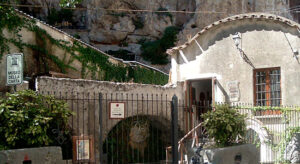MUNICIPALITY: Tramonti
NAME: Terraces of Tramonti
LOCATION: Municipal Area
DESCRIPTION: The cultivated areas of this municipality allow us to understand the high incidence of geological soil composition on the terraced structure. In fact, the soils that constitute the transit and connection areas of the various settlement cores are formed by terraces or ripe. The difference between the two structures lies not only in their appearance but also in the agricultural use of the land. Where the presence of clay is very high, the cultivated area is not bounded at the end by the drystone wall retaining the land, but by an edge consisting of grass that holds the clods in place and is called a ripa. The cultivation plane is sloping and contains vines grown on pergolas. In cases where the soil is not composed of clay then the terracing is bordered by a drystone wall and the cultivation plane is not sloped, and normally the extent of the cultivable area is smaller.
In Tramonti it is possible to see in several places the contiguity between vegetable garden, vineyard, and chestnut forest, which constitutes a system in which each part makes use of the other’s vegetation and organic contribution.
SEE, VISIT, FIND: The best way to see the terraced areas of Tramonti is to position yourself high along the provincial road from Ravello to the Valico di Chiunzi. From here, looking down the valley it is possible to distinguish terraces and ripe. If you want to admire the gardens up close, then just use the road (s.p.141) that from the fraction of Cesarano leads toward that of Polvica and then joins provincial road 157. In addition, driving along the numerous roads leading to the thirteen fractions of the municipality, it is possible to realize that the urban structure of the center fully responds to the agricultural vocation of the area with numerous vegetable gardens on ripe surrounding the residential area.
OPPORTUNITY: The opportunity to see terraced areas both in use and abandoned allows the visitor to understand how this activity has influenced and still influences the hydrogeological structure as well as the economy of the Amalfi Coast.





